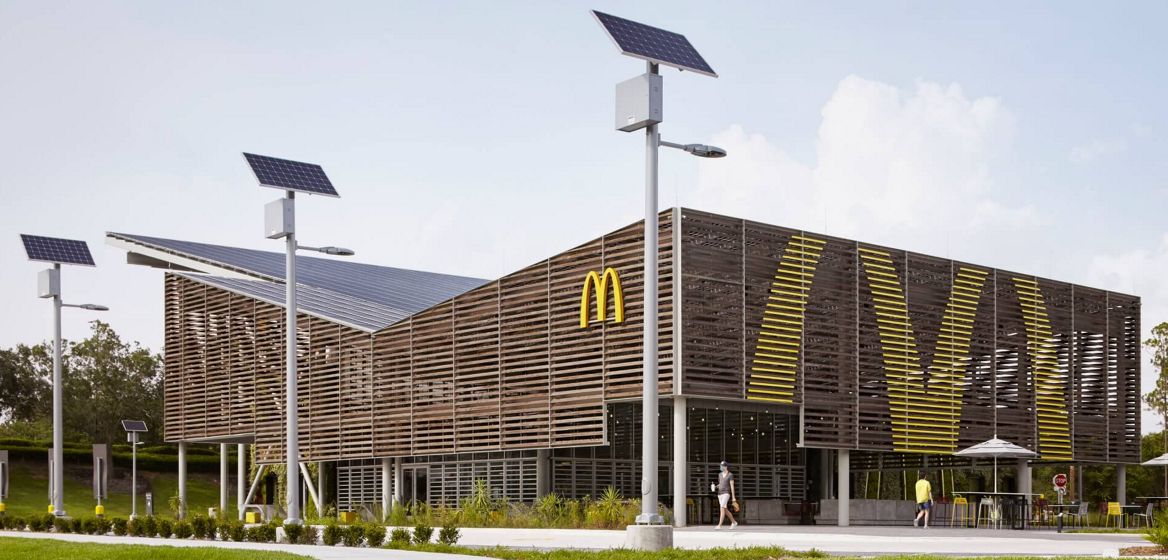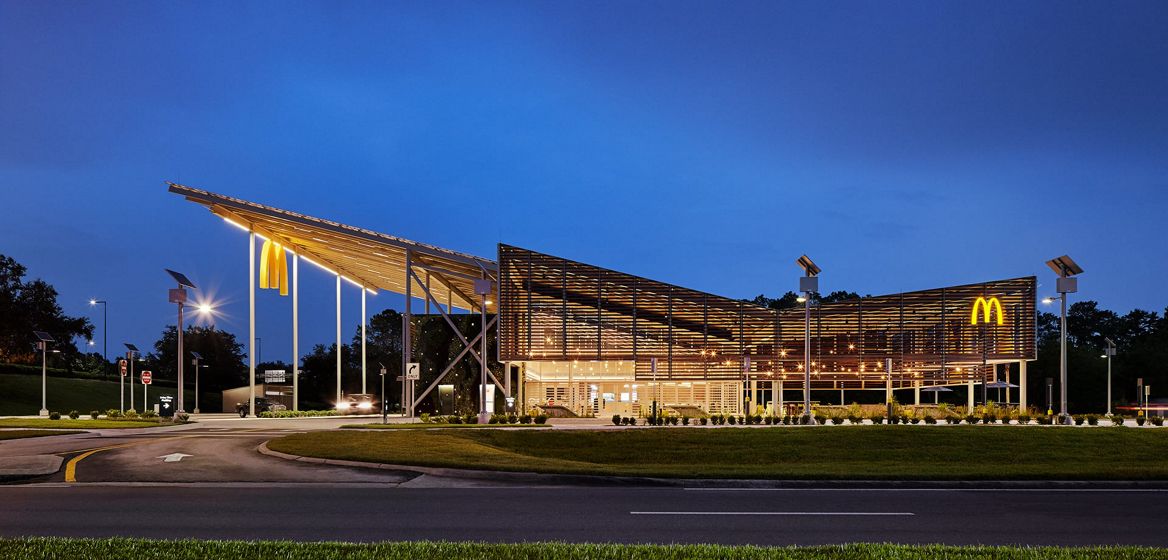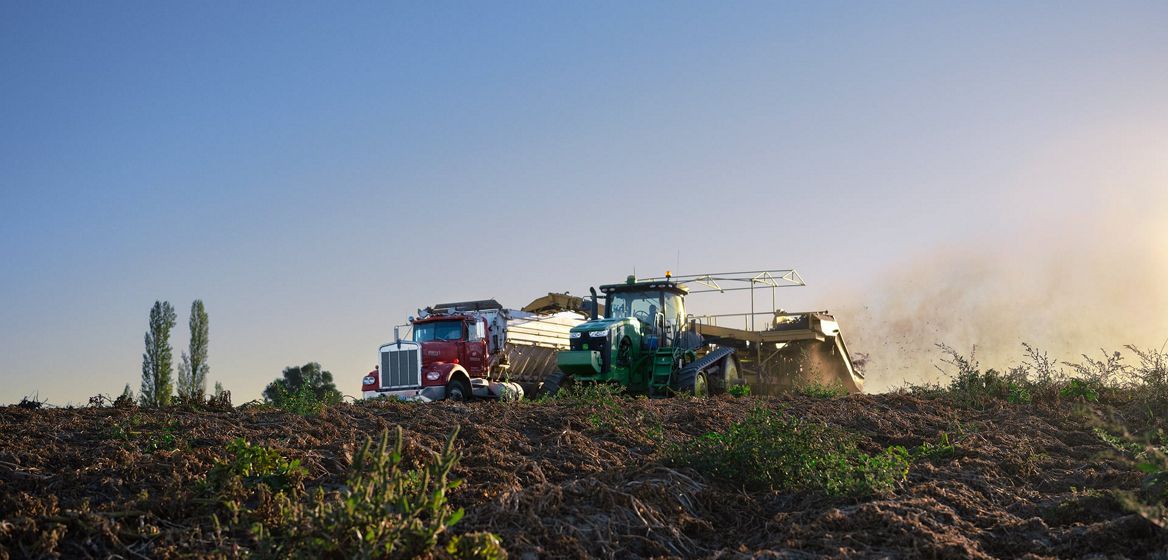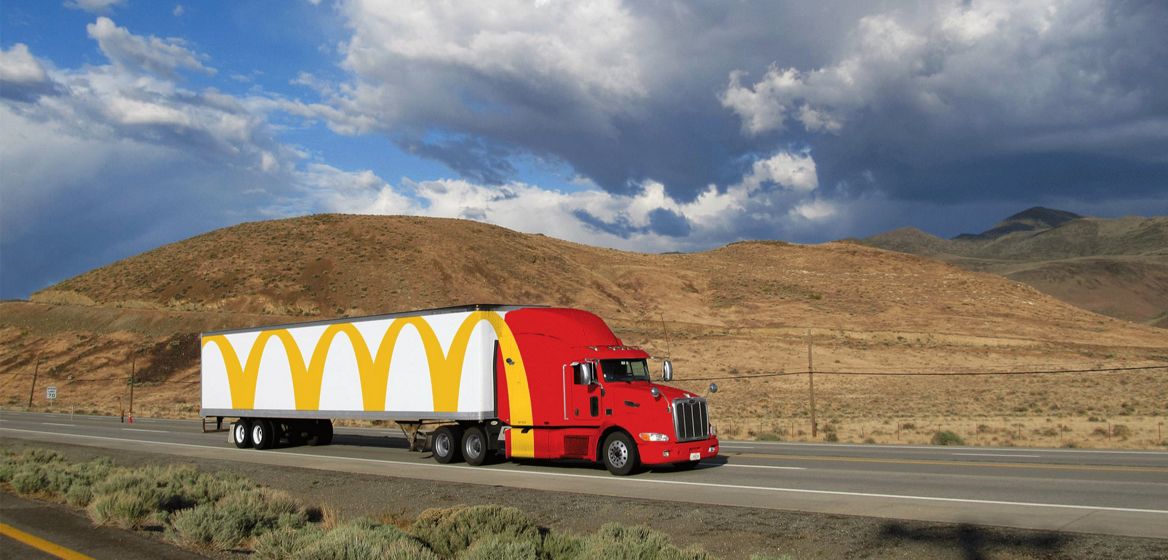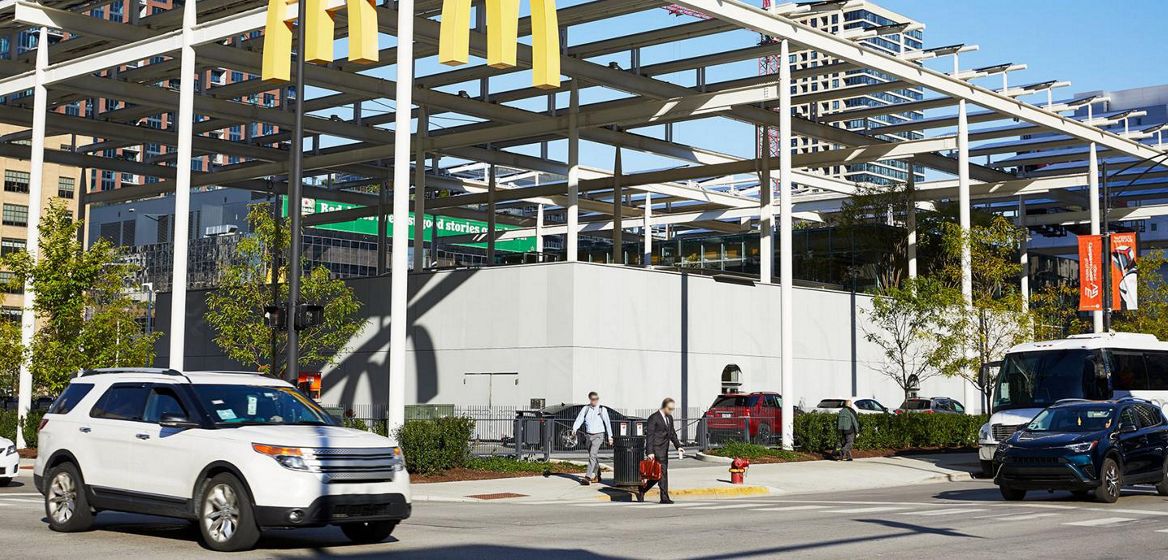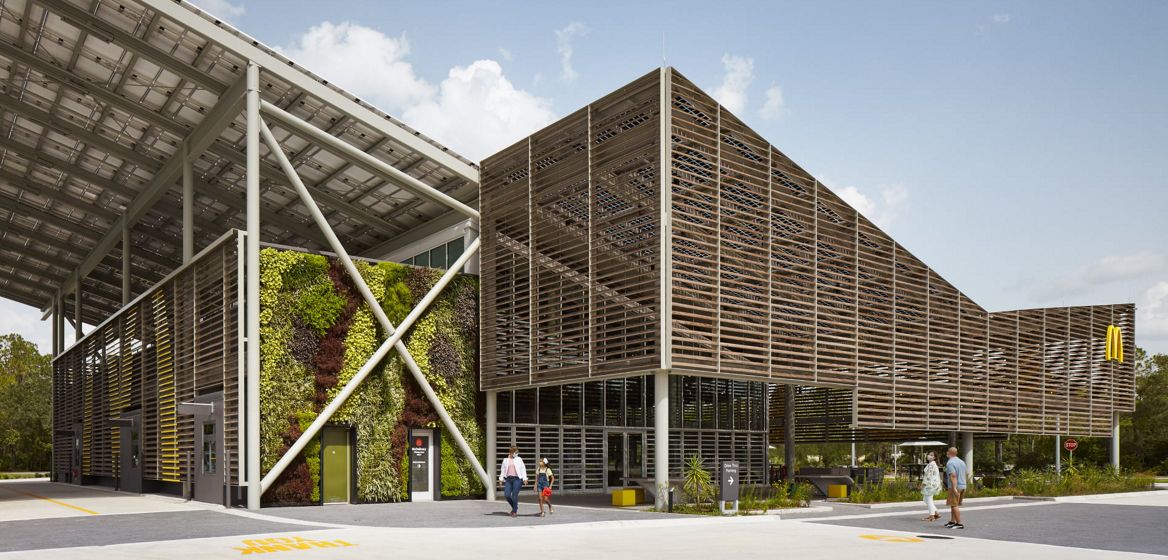Climate Action
We are taking action on climate and transforming our food systems to be more resilient for the future ahead.
Reducing emissions and adapting to climate change is critical to the success of the McDonald’s System. We work toward our climate action ambitions by focusing on reducing emissions in our restaurant operations, engaging suppliers to reduce emissions in supply chains, strengthening our business resilience and using our voice to advocate for collective transformation.
Our Recent Progress
- The Science Based Targets initiative (SBTi) has validated our global 2050 net-zero emission reduction target, aligning our 2030 global emissions target to help keep global temperature rises below 1.5°C.
- We are working with our global beef and chicken suppliers and our dairy and cheese suppliers to set and make progress against climate targets in their businesses.
- We have signed deals, along with our North American Logistics Council (NALC), to purchase renewable energy and associated renewable energy certificates.
- As contracted renewable energy projects executed between 2019–2023 become operational, they are expected to contribute to a 33% reduction in greenhouse gas (GHG) emissions from our global 2015 baseline.
Read our Purpose & Impact Report (PDF – 7 MB) for our progress in more detail.
Our Strategy
Climate change is one of the biggest challenges of our time. Natural disasters and extreme weather patterns pose significant risks to food supply resilience and to communities around the world, including those from which we operate and source. While acting on climate change is challenging and requires significant investment, it is critical to the strength of our business now and in the future.
We have a unique opportunity as a global brand to mobilize the entire McDonald’s System – the Company, Franchisees, suppliers and producers – to catalyze change. With these partners, we are helping to improve our restaurants and food systems and create a better future.
We have embedded our climate goals across our operations and are prioritizing actions in our most carbon-intensive areas, including restaurant energy, supply chain, and packaging and waste.
We continue to implement our strategy through:
- Measuring our energy impact using millions of climate tracking data points, sharing actionable data and benchmarking insights to inform development of our strategy.
- Collaborating to drive and advocate change by partnering with suppliers, Franchisees, industry, governments, nongovernmental organizations (NGO) and others on climate action initiatives.
- Implementing climate solutions in our supply chain through work with suppliers that strengthens regenerative agriculture practices to conserve our forests and reduce emissions.
- Accelerating circularity with packaging and waste strategy, which aims to reduce waste while reducing emissions across our operations and supply chain.
- Increasing energy efficiency in restaurants by designing and operating more sustainable restaurants, embracing practices that conserve energy, as well as increasing renewable energy use, with requirements set in our Global Restaurant Standards (GRS).
On this page, you’ll find out more about our strategy and impact reduction measures across our business.
Our Net Zero Climate Target
In 2018, we committed to reducing greenhouse gas (GHG) emissions related to our restaurants and offices by 36%, as well as the emissions intensity (per metric ton of food and packaging) across our supply chain by 31%, by the end of 2030 from a 2015 base year. These science-based targets were approved by the Science Based Targets initiative (SBTi), and we have continued to work toward them by collaborating with industries, governments, Franchisees, suppliers, consumers and local communities. In 2021, we committed to adapting our climate target to help keep global temperature rises below 1.5°C and reach net-zero emissions by 2050.
Since then, we have worked to evolve our 2030 target. This process included updating both our restaurants and offices target, as well as our supply chain target, based on the latest science and guidance from external experts. As of 2023, we have adjusted our 2030 target, aligned with latest guidance and validated by the SBTi to the following1:
- 50.4% reduction in our absolute scope 1 and 2 GHG emissions related to our restaurants and offices by the end of 2030, from a 2018 baseline.
- 50.4% reduction in our absolute scope 3 GHG emissions related to facility, logistics and plastic packaging in our supply chain by the end of 2030, from a 2018 baseline.
- 16% reduction in our absolute scope 3 forests, land and agriculture (FLAG) GHG emissions related to beef and chicken farming activity by the end of 2030, from a 2018 baseline.
Achieving these ambitions will require continued and immediate action across our full value chain – including our independent suppliers and Franchisees, as well as the support and enabling conditions from government on all levels. Among many other efforts, we intend to continue focusing on adding clean energy to the grid, including through Virtual Power Purchase Agreements (VPPAs), scaling regenerative agriculture practices with our supply chain partners, helping prevent deforestation and ecosystem conversion in key sourcing geographies, and using our voice to advocate for climate positive policies across the globe. As we work toward reaching net zero emissions by 2050, these 2030 milestones will enable positive momentum toward reducing our climate impacts across the McDonald’s System in the near term.
We will continue to work toward driving meaningful progress on our global target, while recognizing that our emissions reduction plans and ambitions may be impacted by elements outside of the Company’s direct control. This may include external policy and geopolitical changes, technological advancements, developments in global climate accounting standards, and the actions of our supplier and Franchisee partners.
Currently, we have aligned our target with the SBTi’s latest 2023 guidance for target-setting, and our measurement approach in accordance with the Greenhouse Gas Protocol, the primary global emissions accounting framework. We will continue to share our progress as accounting frameworks evolve. Any changes to third-party guidance or technologies that were utilized to inform our strategies have the potential to impact our ability to meet our current targets. Given the long-term nature of our strategies, this could result in revision of the assumptions, calculations and targets set by the Company, depending on how standards and measurement capabilities develop.
We also know that we will need external climate accounting standards to continue to evolve in the pragmatic manner in which we anticipate, especially for nature-based solutions, like soil carbon sequestration, renewable energy and land use change, to enable us to meet our current targets.
Our climate ambitions will be balanced with overall Company performance ambitions, including financial growth and continued innovation in our menu offerings and sourcing. The Company’s pursuit of financial growth strategies, including the development of new restaurants and continued sales growth, could also result in an increase in GHG emissions in the near or medium term if the Company does not decarbonize our footprint at a rate greater than our business growth. This balance of our Company-wide objectives and navigating the external environment will remain critical in enabling progress on our climate targets, while also driving our business strategies forward.
Our Comprehensive Disclosure on Climate Action
- Climate Risk & Resiliency Summary 2021 (PDF – 3.82 MB)
- McDonald’s 2022 CDP Climate Change (PDF – 827 KB)
Read more on our approach to eliminating deforestation on our Nature, Forests & Water page and our approach to regenerative agriculture on our Responsible Sourcing page.
Our Performance Data
The figures below reflect our 2022 GHG emissions relative to our 2018 base year, including, as in previous years, all renewable energy VPPAs. These figures have been updated based on third-party guidance around leveraging the latest methodology and most comprehensive data available. As we transition our emissions reduction strategies to work toward meeting our 2050 Net Zero target and recently evolved 2030 global emissions reduction target, we intend to begin reporting target progress in 2024.
The below data has been reported in accordance with CDP methodology. Future reporting of our climate progress in accordance with latest SBTi methodology for our newly formalized targets may differ and impact final progress figures. As we continue to enhance our methodology and data quality over future reporting cycles, we expect the baseline and annual progress figures to adjust accordingly. Although we aim for continuous progress, we acknowledge that change is not a linear journey, and that each year brings new factors that may cause some variability.
GHG Emissions (Metric Tons Carbon Dioxide Equivalent (CO2e))2
Emissions | 2018 (Baseline) | 2022 |
Gross Scope 1 Emissions | 106,963 | 99,441 |
Gross Scope 2 Emissions (market-based) | 364,985 | 238,734 |
Gross Scope 3 Emissions | 62,176,469 | 62,614,064 |
Read more on our approach to eliminating deforestation on our Nature, Forests & Water page and our approach to regenerative agriculture on our Responsible Sourcing page.
How We Measure Our Climate Impact
We hold ourselves accountable by measuring emissions data annually and partnering with experts to report our progress using the latest leading methodologies for data collection and analysis in alignment with the Greenhouse Gas Protocol.
We have an internal, enterprise-level climate tracking system that uses millions of data points to model the emissions from our sourcing, restaurants and operations. The climate tracking system runs parallel with our supply chain sustainability reporting system and other restaurant-related data systems, using common sources of information. We also utilize CDP Supply Chain information to better understand the actions of key suppliers on climate and forests. The climate tracking system is also a way to share actionable data and benchmarking insights with key internal audiences to inform strategy development. Our climate plans and targets are informed by internal and external data sets that may be incomplete, and that continue to evolve over time. This includes, for example, Company growth predictions and emissions footprint measurements for various operational activities and geographies. We will continue to evolve the systems we use through annual reviews of data quality and completeness, climate accounting methodology, and the latest external scientific insights and benchmarking capabilities. Therefore, we expect that going forward our baseline and annual progress figures may adjust accordingly.
We calculate land use change emissions, and they are integrated into our annual carbon footprint reports. To demonstrate the impact of factors such as land use change and carbon sequestration to our footprint and to ensure the resilience of our strategy, we are contributing to the development of globally relevant and accepted GHG accounting methods through various third-party coalitions.
Climate-Related Risks and Opportunities
Impacts of climate change threaten to disrupt agricultural food supply chains, affect infrastructure and pose real risks to vulnerable communities around the world and our own ability to drive climate action and maintain business operations. With these increasing impacts, we are focused on building resiliency across our System to help enable our restaurants and supply chain to adapt to more extreme weather events, higher temperatures, water scarcity, and the potential operating costs associated with each of these impacts.
We are assessing climate risk and strengthening our collective resiliency as recommended by the Task Force on Climate-related Financial Disclosures (TCFD). In 2021, we released our first Climate Risk & Resiliency Summary. The report, which is aligned to the TCFD recommendations, contains more on our climate strategy and our governance and management approach for climate risks.
See our Business Resilience page for more detail.
Collaborating to Drive Change
We know that addressing climate change requires a collective effort across our global community. That is why we’re partnering with our suppliers, Franchisees, industry, governments, nongovernmental organizations (NGOs) and others to take action.
Climate-Related Pledges, Groups and Memberships
Partnerships and collaborations with our peers, Franchisees, policy makers, NGOs and other experts help us to contribute to climate action and advocate for climate policy. We know that the realization of our climate ambitions will require not just significant action from the McDonald’s System, but also from the broader industry, policy makers, and the global economy – and we hope to help enable this change.
For example, McDonald’s is a member of the Clean Energy Buyers Association (CEBA), collaborating with other energy buyers, energy providers and service providers to navigate the complexities of the energy market. McDonald’s also joined the WWF Climate Business Network to exchange ideas with peers on how to reduce emissions in line with our global climate targets.
McDonald’s meets with members of U.S. Congress and its staff to discuss important topics such as recycling, soil health and renewable energy. We believe public policy is a critical part of the solution and our advocacy work in Washington, D.C., is driven by our U.S. Environmental Sustainability Policy Principles.
We are members of the Ceres Business for Innovative Climate and Energy Policy (BICEP) network where, alongside more than 85 other organizations, we advocate for strong climate and clean energy policies in the U.S.
As members of the Gold Standard Value Chain Initiative – a not-for-profit established to ensure projects that reduced carbon emissions featured the highest levels of environmental integrity – we have worked with others to test new techniques of carbon accounting in the supply chain and deal with challenges around traceability.
Additionally, we participated in the Science Based Targets initiative’s (SBTi) FLAG project consultative group, which provided expert advice and direction for companies in land-intensive sections and aimed to ensure criteria for target-setting was clear and practical. This experience helped to inform our own journey to incorporating the latest guidance to our updated SBTi-validated target in 2023.
In 2022, we joined the Consumer Goods Forum (CGF) Forest Positive Coalition. The coalition is a multi-company initiative to stop commodity-driven deforestation and address global climate change issues across the sector. Learn more on our Nature, Forests & Water page.
Climate Action in Our Supply Chain
Together with our supplier partners, we share a commitment to take action to address climate change and drive continuous improvement.
Supplier-Led Climate Action
Our ability to measure and achieve reductions in overall GHG emissions– particularly our Scope 3 emissions – depends greatly on the work and collaboration of our suppliers. We expect all McDonald’s suppliers to set climate targets, measure their emissions and achieve reductions line with their broader sustainability strategies. This expectation is communicated to suppliers by our sourcing teams and is assessed through CDP disclosures and other reporting feedback mechanisms. We regularly reinforce the importance of action during supplier webinars and reviews, and support suppliers with a Climate Action Toolkit.
Through our climate data and insights platform, we model the various impacts suppliers and sourcing categories have on our emissions. These insights allow us to target our work with suppliers on strategies that support our science-based targets and reduce our collective climate impact.
Nature-Based Climate Solutions
We believe in the power of sustainable agriculture practices to increase biodiversity, enrich soils and boost climate resilience. At McDonald’s we look to scale the adoption of regenerative agriculture principles to build more resilient supply chains, drive action against our climate goals, and help protect delicate ecosystems.
Read our approach to eliminating deforestation on our Nature, Forests & Water page and our approach to regenerative agriculture on our Responsible Sourcing page.
Managing Our Transport and Logistics Impact
McDonald’s System logistics network transports our food products across more than 250 million miles every year.
We have a two-fold approach to working with our suppliers to achieve world-class logistics operations with the lowest feasible environmental footprint:
- Driving fewer miles and using less fuel through continuous routing improvements, innovations like engineless cooling and air deflectors, and ongoing driver training.
- Increasing the use of alternative fuels with lower emissions, including renewable natural gas created from biowaste, biofuels, hydrogen, natural gas, propane and electricity. Where possible, these biofuels are generated from by-products rather than crops grown for food.
All of McDonald’s global and North American independent logistics suppliers have set science-based targets, approved by the SBTi.
In 2017, 2019, 2020 and 2021, McDonald’s U.S. received a SmartWay Excellence Award for outstanding environmental performance and leadership from the Environmental Protection Agency (EPA) for using high-performing SmartWay carriers for its logistics supply chain.
Restaurant Energy
As of the end of 2022, restaurant energy use represented 59% of our restaurant and operations baseline emissions footprint, and as such, represents a key focus area for accelerating progress against our 2030 targets.
With restaurants in over 100 markets across the world, we are working with our Franchisees on innovative solutions for creating and managing increasingly sustainable and efficient locations. This includes investing in areas such as renewable energy, LED lighting, energy-management systems and energy-efficient kitchen equipment. Across the globe, our markets are in various phases of strategy development and implementation. McDonald’s is also taking steps to procure and use renewable electricity, which requires ongoing collaboration with our markets, Franchisees, including International Developmental Licensees, as well as local governments to help support the growth of renewable energy and other enabling policies.
Adding Renewable Energy to the Grid
One of the most effective and timely actions we can take to reduce our electricity-related emissions footprint is to invest in renewable energy to cover restaurant needs. We are increasingly looking for solutions to power more of our sites renewably as a key part of our strategy to reduce emissions related to our restaurant operations.
Since 2019, McDonald’s has signed fourteen renewable energy projects through virtual power purchase agreements (VPPAs) and continues to be among other leading corporate renewable energy buyers in adding new, large-scale renewable energy to the U.S. grid. Our renewable energy projects cover both solar and wind technologies, and are planned to be located in Texas, Illinois, North Carolina, Ohio and Louisiana.
As the projects for which contracts were executed between 2019–2023 continue becoming operational over the next few years, the energy generated is expected to be the equivalent of more than 11,700 restaurants’ worth of electricity. Once operational, McDonald’s portion of these renewable energy projects is expected to help cover approximately 3,600,000 metric tons of CO2e emissions associated with electricity production annually, which is roughly equal to the 2021 carbon footprint of Minneapolis, MN.
While this represents the impact of our contracted projects, the landscape of the renewable energy industry continues to experience supply chain issues and other headwinds and we also recognize that the impact from some contracted projects in the portfolio could be replaced with other future projects. As renewable energy is a key driver to our overall climate strategy, we also continue to work with our Franchisees across markets to understand the energy landscape on a local level. Our ability to meet our SBTi-validated target may be impacted if third party accounting methodologies do not enable or recognize McDonald’s procurement of renewable electricity to account for Franchisee restaurant emissions.
We continue to monitor the progress of all projects to ensure they meet our selection criteria as we make progress toward our climate targets.
Accelerating Circularity
How our packaging and toys are designed, produced, transported, disposed, and recovered impacts the planet. Our packaging, toys, and waste strategy aims to accelerate a circular economy approach – reducing waste while also reducing emissions across our operations and supply chain. To continue reducing Scope 3 emissions related to packaging and waste, McDonald’s requires ongoing collaboration with our suppliers, markets, Franchisees & International Developmental Licensees, as well as customers, external organizations and local governments to help establish robust recycling systems, aligned and enabling policies, and innovations to meet customer expectations.
Read more on our Packaging, Toys & Waste page.
Designing and Operating More Sustainable Restaurants
We are focused on designing and delivering as many resource-efficient restaurants as possible. This means minimizing our use of energy and water, and maximizing the use of renewable energy, wherever possible.
Our Global Restaurant Standards (GRS) include minimum requirements and recommendations across areas such as lighting, refrigeration and the energy efficiency of heating, ventilation and air conditioning systems, as well as energy management.
To advance the overall sustainability of McDonald’s restaurants, we also employ a standard global guide for reducing GHG emissions across all new store openings as part of our continuous efforts to reduce energy consumption by sharing best practice. We are also building out a menu of sustainable décor options, which Franchisees can choose to adopt across all markets.
Installing Electric Vehicle Charging Points at Our Restaurants
Some of our markets are exploring ways to help our customers and employees reduce their own environmental impact. For example, to help our customers embrace more sustainable technologies, several markets around the world offer electric vehicle (EV) charging points at restaurant locations.
Footnotes
1 McDonald’s SBTi-validated target in full: McDonald’s Corporation commits to reduce absolute scope 1 and 2 GHG emissions 50.4% by 2030 from a 2018 base year. McDonald’s Corporation also commits to reduce absolute scope 3 energy and industrial GHG emissions from purchased goods and services, fuel and energy related activities, upstream transportation and distribution, waste generated in operations, end-of-life treatment of sold products, and franchises 50.4% within the same timeframe. McDonald’s Corporation commits to reduce absolute scope 3 FLAG GHG emissions 16% by 2030 from a 2018 base year. McDonald’s Corporation also commits to maintain no deforestation across its primary deforestation-linked commodities.
2 The 2022 Scope 3 data point reported above varies slightly from what was reported in McDonald’s response to the 2023 CDP Climate Change questionnaire. This is due to an update to the figures used for calculation that was made following our CDP submission. The 2022 figures do not include data for Scope 3 Category 2 Capital Goods which will be included in our 2023 reporting. The above figures include the impact through 2022 of the Corporate backed VPPA program in the U.S.
3 While McDonald’s is actively working to achieve its environmental, social, and governance (“ESG”) goals, these goals are forward-looking statements that reflect expectations as of the date of this statement, not historical facts or guarantees of future performance, achievement, or results. There is no guarantee that the Company will meet its goals or increasing stakeholder ESG expectations. Various factors could cause actual results to differ, including those described herein and in the Company’s Annual Report on Form 10-K, other SEC filings, and in our 2022-2023 Purpose & Impact Report and Goal Performance and Reporting page.

